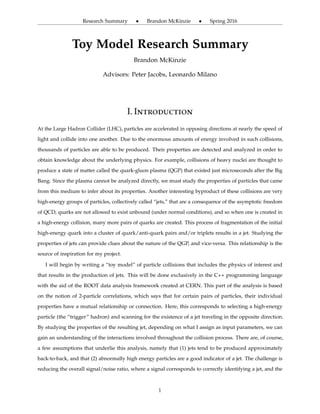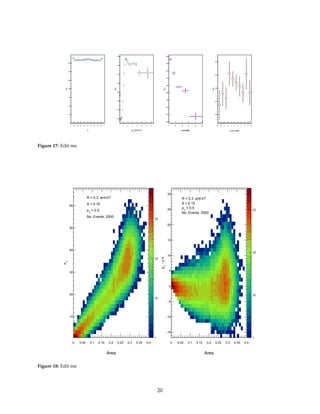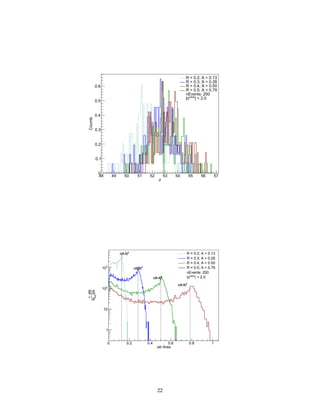This document summarizes a research project that involves building a toy model of particle collisions using C++ and ROOT. The model simulates collisions by sampling probability distributions measured in real collisions. It generates particles and assigns them properties like momentum and angle. It also models physical processes like jet production and elliptic flow. The goal is to study how properties of particles like jets are affected by a quark-gluon plasma and vice versa. The model allows tuning parameters to learn about collision interactions and switch physics processes on or off.

![noise corresponds to clusters of particles that we erroneously call a jet.
The novelty of this project is in building a model from scratch that relies almost exclusively on sampling
probability distributions from recorded data while also being capable of switching on/off physical process
of interest, such as correlated hadron-jet pairs and the effects of elliptic flow. As of May 13, when this draft
was written, there is still plenty of work to be done, and the project is far from over. This document thus
serves as a summary of what has been done in the past few months with a brief discussion of the next
steps to be taken.
II. Theory
The model relies on a set of commonly used functional forms to describe distributions. Collision events
are simulated via Monte Carlo sampling of measured and/or known probability distributions. The main
particle properties we will be studying are transverse momentum pT, η, and φ. The pseudorapidity,
denoted η, is roughly equivalent to rapidity when pT >> m. It is convenient in that particle production is
approximately uniform over the possible values of η, which are constrained by detector geometry, since
η ≡ −ln tan
θ
2
(1)
which shows the functional dependence of η on the polar angle θ. The ALICE detector provides good
detection in |η| < 1, and we will restrict our analysis to charged particles at mid-rapidity, |η| < 0.8 to
account for any undesirable fringe effects.
The most naïve approach would assume uniformity in both η and ϕ. However, when two nuclei collide
with a non-zero impact parameter, the spatial overlap in the transverse plane no longer looks spherical, but
can take on an almond shape of the form seen in figure 1 below. This results in a non-uniform density
Figure 1: Schematic picture of elliptic flow in the transverse plane. Source: ref. [5].
2](https://image.slidesharecdn.com/8a9a1c4f-e956-49c7-b338-1d03c03f642d-160608012011/85/Report-2-320.jpg)
![distribution of particles, also called a spatial anisotropy. Soon thereafter, as the spatial anisotropy lessens, it
is “converted” into a momentum anisotropy among the particles, which allows one to measure the degree
of elliptic flow in each event. Specifically, the predicted number of particles produced at a given value of ϕ
is proportional to a quantity denoted as v2, where
dN
dϕ
∝ 1 + 2v2cos[2(ϕ − ψEP)] (2)
and ψEP represents the angle of the event-plane in ϕ.
Somewhat similarly, the analysis of two-particle correlations is done using distributions of the differences
between two particles’ properties. For example rather than plotting dN/dϕ of particles, we would plot
dN/d∆ϕ where ∆ϕ is between a specific trigger particle and all others. If any correlations exist, we would
expect to observe a particular structure in such plots for certain regions of the phase space.
There is an observed suppression of hadron production in heavy-ion collisions as compared to indepen-
dent superpositions of nucleon-nucleon collisions. This is expected to be due to energy loss of the partons
as they propagate through the hot and dense QCD medium [1]. To quantify nuclear medium effects at
high pT, the so called nuclear modification factor RAA is used. Defined as ratio of charged particle yield in
Pb-Pb to pp, scaled by number of binary nucleon-nucleon collisions:
RAA(pT) =
(1/NAA
evt )d2NAA
ch /dηdpT
Ncoll (1/N
pp
evt)d2N
pp
ch /dηdpT
(3)
where we use the measured value of Ncoll = 1690 ± 131 for 0 - 5% centrality.
Jet Reconstruction
The two essential stages for any jet algorithm involve (1) identifying the objects belonging to a cluster,
and (2) calculating the kinematic variables that define the jet from the objects defining the cluster [3]. The
clustering algorithm used here, the anti-kT algorithm, relies on the association of measured particles based
on their transverse momentum1
Before defining what is meant by the “anti” in anti-kT, let’s consider the (longitudinally-invariant) kt
algorithm for hadron collider. The algorithm is initialized with a vector of partons from the event, and
each is considered as a proto(or pseudo)-jet. Then, the following distance measures are computed for each
parton/parton pair: (1) dij between all pairs of particles i and j, and (2) diB = p2
ti between every particle i
1This is contrast with clustering done by cone algorithms, which associate particles based on angles relative to a jet axis.
3](https://image.slidesharecdn.com/8a9a1c4f-e956-49c7-b338-1d03c03f642d-160608012011/85/Report-3-320.jpg)
![and the beam, where
dij = min(p2
ti, p2
tj)
∆R2
ij
R2
(4)
and ∆R2
ij = (yi − yj)2 + (ϕi − ϕj)2 is the distance in (y, ϕ) space between i and j. The parameter R,
informally referred to as the “jet radius,” determines the angular reach of the algorithm [7]. If the minimum
value of these quantities is a diB, then i is designated as a jet; if it is a dij, then i and j are combined into a
single proto-jet by summing their four-vector components. If two particles/objects are merged, they are
replaced in the list by the object resulting from summing their four-vectors [4]. This is repeated until all
proto-jets have become jets. Mathematically, the algorithm terminates when the following evaluates as true:
(!∃i, j)(k2
T,(i,j) < k2
T,i).
The anti-kt jet algorithm uses the distance measures
dij = min(1/p2
ti, 1/p2
tj)
∆R2
ij
R2
(5a)
diB = 1/p2
ti (5b)
, it behaves in some sense like a “perfect” cone algorithm , in that its ard jets are exactly circular on the
y − φ cylinder. We can see that the consequence of inverting all the values (e.g. 1/pT) is that the highest-pT
objects are clustered first.
One way of correcting for background contamination of hard jets involves the use of jet “areas,” which
provide a measure of a given jet’s susceptibility to soft contamination. Jet areas can be determined by
examining the clustering of a large number of additional infinitesimally soft “ghost” particles. Inclusive jets
correspond to all objects that have undergone a “beam” clustering (diB recombination).
III. Particle Generation
Various implementations responsible for generating the particles were explored throughout the course of
the semester. First, an overview will be given of our initial approach, and then a more detailed account will
be given on the current methods employed for particle generation. The first steps were to sample some (as
of yet undetermined) number of particles uniformly within |η| < 1 and 0 < ϕ < 2π. Initially, the model
used the following pT sampling distribution, courtesy of Redmer Alexander Bertens.
P(x) ∝ A(B2
xe−Bx
) + (x > 1)C 0.12 D2 + x2 1 +
1
(0.82)(E)
D2 + x2
−E 1
1 + e− x−F
G
(6)
4](https://image.slidesharecdn.com/8a9a1c4f-e956-49c7-b338-1d03c03f642d-160608012011/85/Report-4-320.jpg)
![background phi
0 1 2 3 4 5 6
counts
0
2000
4000
6000
8000
10000
background eta
1− 0.5− 0 0.5 1
counts
0
2000
4000
6000
8000
10000
12000
background pt
0 1 2 3 4 5
counts
0
50
100
150
200
250
300
350
400
3
10×
background phi
1− 0.5− 0 0.5 1
backgroundeta
0
1
2
3
4
5
6
Figure 2: Basic distributions for single particles sampled in phi, η, pt, and phi vs. eta.
with the fitting parameters, denoted by capital letters, initialized with the values in table 1. With the help
of the ROOT libraries, this simple implementation alone was able to plot basic particle spectra as seen in
figure ??.
At this stage, such particles were referred to as “background” particles, as they were sampled randomly
from a (generally) soft distribution. Since we are interested in two-particle correlations associated with
jet production, we also designate a single high-pT particle per event as a “trigger” particle, with a
corresponding “associated” particle opposite to it in η and φ. The associated particle’s phi is also Gaussian
smeared, centered at π radians from the trigger with some standard deviation σ ≈ 0.2. The trigger-
associated particle pairs will later serve as what is known as an h+Jet pair. These assumptions are made
from the perspective of two-particle correlations, which stem from the notion that, in the early stages of the
collision, particles can be produced back-to-back with very high momenta.
Next, we incorporate a non-zero v2 parameter, which varies as a function of the given particle’s pT, that
provides information regarding elliptic flow. Specifically, it is known that, in the presence of flow, particles
are not generated uniformly in φ, but rather they exhibit a dependence on v2 in the form,
dN
dφ
∝ 1 + 2v2cos[2(φ − ψEP)] (7)
where ψEP represents the angle of the event-plane in φ. For now, we simplify this by setting ψEP = 0.
A B C D E F G
2.43 ×109 2.99 1.01 ×107 0.14 5.6 2.8 0.2
Table 1: Initial values of fit parameters for the first sampling pT distribution used by the model.
5](https://image.slidesharecdn.com/8a9a1c4f-e956-49c7-b338-1d03c03f642d-160608012011/85/Report-5-320.jpg)

![Figure 5: [Source: Figure 2 of ref. [1]]The pT distributions of primary charged particles at mid-rapidity (|h| < 0.8)
in central (0–5%) and peripheral (70–80%) Pb-Pb collisions at
√
sNN = 2.76 TeV. Error bars are statistical only. The
systematic data errors are smaller than the symbols. The scaled pp references are shown as the two curves, the upper
for 0–5% centrality and the lower for 70–80%. The systematic uncertainties of the pp reference spectra are contained
within the thickness of the line.
flow should not greatly alter this shape. However, if we also include differences between the trigger and
background in this distribution, we expect the modulation introduced from a non-zero v2 to show up as a
modulation in the overall ∆φ distribution. We show how v2 affects both (1) the differences between trigger
and all particles and (2) the differences between just trigger and associated particles in figure 4. Since
the trigger itself is more likely to be found in regions along the event-plane, one would expect it to be
more probable that any given be particle be found at nearly the same ϕ or directly opposite from it. The
triangular shape of the δη distribution is what one would expect for differences taken between pairs of
variables all sampled uniformly over [-1, 1] (i.e. it is due to the geometry of our acceptance)
The current implementation relies almost exclusively on sampling from published data to generate
particles and their properties. The pT distribution for the soft background, shown in figure ??, is from
the same ALICE 2010 data we will soon be comparing with [1]. This also provides us a way to check
that our sampling behaves as expected, as we will be able to plot our model’s pT distribution against the
raw data after we apply the appropriate corrections and normalization factors. We now fit the published
pT distribution with a simpler functional form proposed by Hagedorn to describe experimental hadron
7](https://image.slidesharecdn.com/8a9a1c4f-e956-49c7-b338-1d03c03f642d-160608012011/85/Report-7-320.jpg)
![Figure 6: A CMS event containing a leading and subleading jet, indicated in red. Credit: Alexander Schmah.
production data as a function of pT over a wide range [6].
E
d3σ
d3 p
= C 1 +
pT
p0
−n
(8)
Although simple in appearance, this function proved to fit the distributions quite well.2
IV. Jet Finder
Now that we can properly generate basic events with high-multiplicity and particles exhibiting elliptic flow,
we can begin searching for the existence of jets. The easiest way to begin this task is to artificially embed a
jet in a known location in the eta-phi phase space and tell our jet finder to search for it; if it reports finding
our embedded jet, and our embedded jet only, we have succeeded in writing an elementary jet finder. From
there, we will improve it so that it can handle more realistic (and much more challenging) events.
After embedding a jet in our simulation over the background, we should expect to see something
like Figure 6 upon plotting eta vs. phi. Any competent jet finder ought to be able to select the particles
displayed in red, which can be distinguished by their abnormally high transverse energy. Although finding
such outliers may seem like a straightforward task, we are seldom presented with the clean-cut distinctions
seen in figure 6. More often, we will be tasked with determining which clusters of particles in a sea of
possibly thousands of background tracks were produced by a hard scattering process.
2One unintended but amusing result was discovered upon plotting the ratio of our model over the reconstructed AOD data that
deviated significantly from unity. It turned out that our model was sampling from the scaled pp reference in figure ?? and thus our
ratio was actually RAA(pT); we had verified the published dependence of RAA with pT on accident.
8](https://image.slidesharecdn.com/8a9a1c4f-e956-49c7-b338-1d03c03f642d-160608012011/85/Report-8-320.jpg)
![jet
T
p
0 10 20 30 40 50 60
T
dp
dN
evtN
1
3−
10
2−
10
1−
10
1
= 2000evtN
R = 0.3, anti-kT
jet
η
0.6− 0.4− 0.2− 0 0.2 0.4 0.6
ηd
dN
evtN
1
0
5
10
15
20
25
30
35
40
= 2000evtN
R = 0.3, anti-kT
jet
ϕ
0 1 2 3 4 5 6
ϕd
dN
evtN
1
0
1
2
3
4
5
6
7
= 2000evtN
R = 0.3, anti-kT
Figure 7: Basic jet quantities corresponding to the simplest simulation settings. Specifically, these correspond to 2000
generated events, each with (fixed) track multiplicity of 16673. Tracks have sampled distributions like those seen in
figure 2. Track acceptance is restricted to |η| < 0.9. No minimum value of jet pT, typically denoted as pT,min, is passed
to FastJet.
The toy model both generates the events as well as analyzing them with the help of the FastJet
framework. The particles are clustered using the anti-kT algorithm with a default value of R = 0.3 unless
stated otherwise (we will soon explore how varying R can alter results). The clustering returns a vector
of PseudoJet objects, which represent the proto-jets discussed earlier in the Theory section. To begin we
explore various scenarios/checks on the jet finder to ensure quality performance. For now, we analyze the
case of model particle generation with (a) v2 set to 0, (b) track multiplicity constant for all events, and (c)
a 100% tracking efficiency (i.e. all simulated particles are successfully “detected”). This is important for
developing a baseline reference before incorporating the more complex model parameters.
The simplest results are shown in figure 7 with all relevant details regarding how the events were
generated addressed in the caption. It is important to note that, since no transverse momentum cut is
applied to the accepted jets, the number of jets found in the events are not infrared safe quantities [7].
For now, this cut (which is typically included) is omitted because it will be useful for estimating the soft
background/underlying event.
Although the pT and ϕ distributions match expectations4, η will prove to exhibit unanticipated behavior
throughout the remainder of this report. For this reason, we will scrutinize it in greater detail as an attempt
to discover the root cause of its shape. In theory, we would expect the jet η distribution to be flat, as is the
case for the single-particle tracks; there is no reason a priori that jets should be detected preferentially in
certain regions of η but not others. The most likely explanation, and the explanation that I will make a case
for throughout the report, is that the strange shape is ultimately a geometrical consequence of clustering
3This value is the measured charged particle multiplicity for collision centralities of 2.5% from ALICE data in reference [1].
4Given that no cuts have been applied at this stage.
9](https://image.slidesharecdn.com/8a9a1c4f-e956-49c7-b338-1d03c03f642d-160608012011/85/Report-9-320.jpg)







![References
[1] ALICE Collaboration. Suppression of Charged Particle Production at Large Transverse Momentum in
Central Pb-Pb Collisions at
√
sNN = 2.76 TeV. arXiv:1012.1004v1 (nucl-ex), 2010.
[2] Alexander Schmah. Jet Production in Au+Au Collisions at STAR. Presentation.
[3] J. M. Campbell, J. W. Huston and W. J. Stirling, Rept. Prog. Phys. 70, 89 (2007). [arXiv:hep-ph/0611148]
[4] S. Ellis, et al. Jets in Hadron-Hadron Collisions. (2007). arXiv:0712.2447.
[5] Ullrich Heinz. Concepts in Heavy-Ion Physics. Department of Physics, The Ohio State University, Colum-
bus, OH 43210, USA.
[6] C. Wong and G. Wilk. Tsallis Fits to pT Spectra and Multiple Hard Scattering in pp Collisions at LHC.
arXiv:1305.2627
[7] M. Cacciari et al., “Fastjet user manual”
17](https://image.slidesharecdn.com/8a9a1c4f-e956-49c7-b338-1d03c03f642d-160608012011/85/Report-17-320.jpg)





